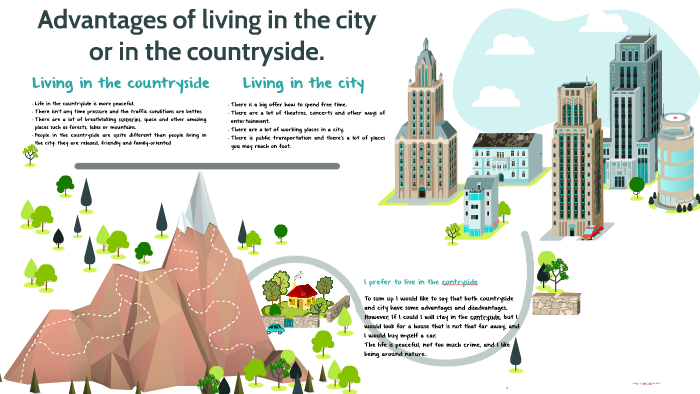Advantages and Disadvantages of City and Urban Life

Advantages of City Living

The Urban Haven: Embracing Diversity and Opportunities
Living in a city offers a myriad of advantages. The bustling urban landscape provides access to diverse cultures, entertainment options, and a plethora of career opportunities. Cities are hubs of innovation and progress, fostering a dynamic environment that encourages personal and professional growth. Access to top-notch healthcare, educational institutions, and modern amenities is a hallmark of city living. Additionally, public transportation networks and proximity to various services make city life convenient.
Disadvantages of City Living:
The Flip Side of Urban Bliss: Challenges in the Metropolis
However, urban living comes with its set of drawbacks. The fast-paced lifestyle can lead to stress and a sense of isolation. High living costs, crowded spaces, and noise pollution are common challenges. Moreover, the constant rush can sometimes impede meaningful connections and a sense of community.
Advantages of Country Living

Tranquility in Nature’s Embrace: Countryside Charms
In contrast, life in the countryside offers tranquility and a closer connection to nature. The peaceful surroundings promote a slower pace of life, fostering a sense of serenity and well-being. Cleaner air, expansive landscapes, and a stronger sense of community contribute to a more relaxed lifestyle.
Disadvantages of Country Living:
Navigating Rural Realities: Trade-Offs Beyond the Urban Fray
Yet, rural living may present challenges such as limited access to services, fewer employment opportunities, and a lack of cultural diversity. Distance from urban centers might also mean longer commutes and reduced access to certain conveniences.

Conclusion:
Balancing Urban Dynamism and Rural Serenity: A Lifestyle Choice
Ultimately, the choice between city and countryside living hinges on individual preferences and priorities. Each lifestyle offers a unique set of advantages and disadvantages, catering to diverse needs and desires. Whether embracing the vibrancy of city life or seeking solace in the tranquility of rural landscapes, both environments shape distinct experiences and trade-offs in the pursuit of an ideal living space.
References
- Goodall, B. (1987) The Penguin Dictionary of Human Geography. London: Penguin.
- Kuper, A. and Kuper, J., eds (1996) The Social Science Encyclopedia. 2nd ed. London:; Routledge.
- Caves, R. W. (2004). Encyclopedia of the City. Routledge. p. 99.
- Glaeser, Edward (2011). “Cities, Productivity, and Quality of Life”. Science. 333 (6042): 592–594. Bibcode:2011Sci…333..592G. doi:10.1126/science.1209264. PMID 21798941. S2CID 998870.
- Bettencourt, Luis; West, Geoffrey (2010). “A unified theory of urban living”. Nature. 467 (7318): 912–913. Bibcode:2010Natur.467..912B. doi:10.1038/467912a. PMID 20962823.
- Ritchie, Hannah; Roser, Max (13 June 2018). “Urbanization”. Our World in Data. Archived from the original on 29 October 2020. Retrieved 14 February 2021.
- James, Paul; with Magee, Liam; Scerri, Andy; Steger, Manfred B. (2015). Urban Sustainability in Theory and Practice: Circles of Sustainability. London: Routledge. ISBN 978-1315765747. Archived from the original on 1 March 2020. Retrieved 20 December 2017.
- “Rise of the City”. Science. 352 (6288): 906–907. 2016. doi:10.1126/science.352.6288.906. PMID 27199408.
- “Cities: The century of the city”. Nature. 467 (7318): 900–901. 2010. doi:10.1038/467900a. PMID 20962819.
- Sun, Liqun; Chen, Ji; Li, Qinglan; Huang, Dian (2020). “Dramatic uneven urbanization of large cities throughout the world in recent decades”. Nature Communications. 11 (1): 5366. Bibcode:2020NatCo..11.5366S. doi:10.1038/s41467-020-19158-1. PMC 7584620. PMID 33097712.
- “Cities: a ’cause of and solution to’ climate change”. UN News. 18 September 2019. Archived from the original on 4 March 2021. Retrieved 20 March 2021.
- Merite, Gabrielle; Vitorio, Andre. “How megacities could lead the fight against climate change”. MIT Technology Review.
- “Sustainable cities must be compact and high-density”. The Guardian News. 30 June 2011. Archived from the original on 9 March 2021. Retrieved 20 March 2021.
- Angelo, Hillary; Wachsmuth, David (2020). “Why does everyone think cities can save the planet?”. Urban Studies. 57 (11): 2201–2221. Bibcode:2020UrbSt..57.2201A. doi:10.1177/0042098020919081.
- Bibri, Simon Elias; Krogstie, John; Kärrholm, Mattias (2020). “Compact city planning and development: Emerging practices and strategies for achieving the goals of sustainability”. Developments in the Built Environment. 4: 100021. doi:10.1016/j.dibe.2020.100021. hdl:11250/2995024.
- “Ch2”. www-personal.umich.edu. Archived from the original on 4 August 2020. Retrieved 10 May 2021.
External links:
- World Urbanization Prospects, Website of the United Nations Population Division (archived 10 July 2017)
- Urban population (% of total) – World Bank website based on UN data.
- Degree of urbanization (percentage of urban population in total population) by continent in 2016 – Statista, based on Population Reference Bureau data.
- Human Geography at Curlie
- Urban and Regional Planning at Curlie
1 comment